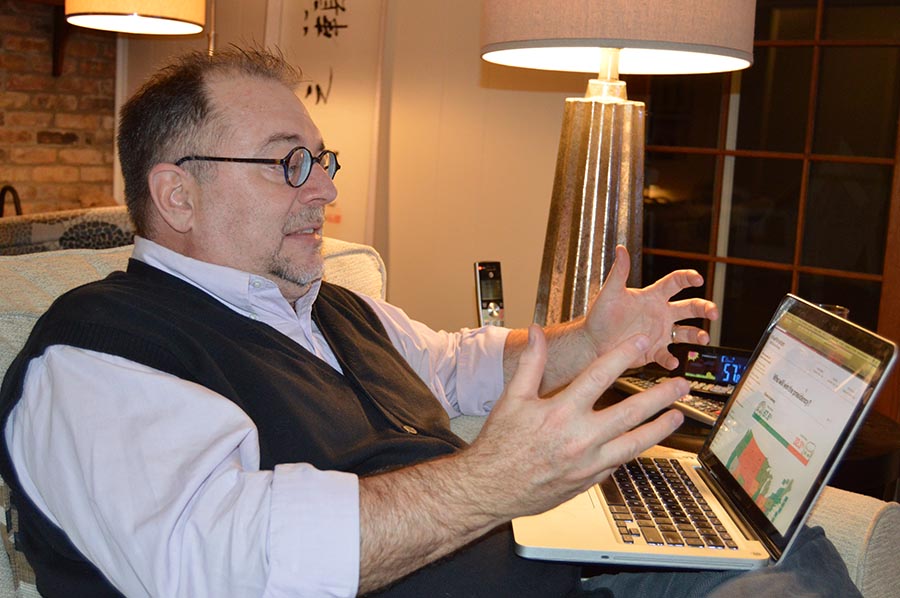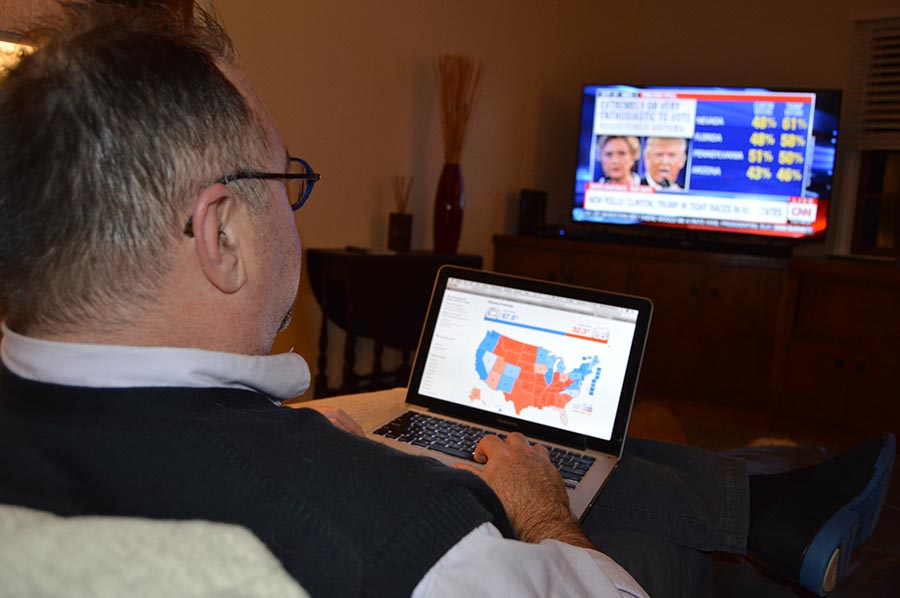Got polling fever? Five points for surviving until the election results tonight

Mitchell Robinson has a virus that’s been going around. He can’t sleep. He has wild mood swings. And he has a telltale bruise on his thumb.
“It’s from hitting refresh on the (polling) websites,” Robinson said.
Last Wednesday, six days before the presidential election, the 58-year-old sat on a couch in the basement of his Okemos home. The latest polling from four swing states glared out from a big screen TV. Robinson toggled between browsers on a laptop perched on the arm of the sofa, and the popular polling data site Fivethirtyeight popped up. He looked at the latest polling numbers, groaned and put his hands on his head.
“It’s terrible,” said Mitchell. “I don’t know if I can make it until Nov. 8.”
The maddening variance of polls has turned the 2016 presidential election into a slow-motion root canal. That ends tonight when polls close. But until then, here are five things to know about the accuracy of these surveys for the poll-obsessed.
1: Polling is getting harder and more expensive. Fewer people have land lines, and even those who do often screen their calls by looking at Caller ID, said Michael Traugott, polling expert and professor in the Center for Political Studies at the University of Michigan. Pollsters try to reach voters on cell phones, too, but run into the same problem – people don’t pick up their phones or decline to answer questions.
“Response rates are 7-9 percent,” Traugott said.
Let that sink in: the polls you are obsessing over are culled from the responses of the one out of 12 people who have the inclination to answer a series of questions from a stranger or automated call.
2. Different people answer the phone at different rates, making accurate polls even harder. Look at this chart: It takes 10 attempts for a pollster to reach and get a complete survey from a white woman over the age of 65; it takes about 300 attempts to reach and complete a survey from a young Hispanic man.
“At night, after the kids are in bed and I’m having a gin and tonic, if the phone rings and it’s a pollster, I’ll answer it,” Robinson said. “But I’m a political junkie. That kind of response rate makes you wonder what kind of sick, twisted people are responding in these polls.”
3. So are polls less accurate today? “In the old days, in the ‘80s and early ‘90s, you’d have a good (polling) sample, collect information and essentially add it up,” Traugott said. “You can’t do that anymore.”
A Bridge primer on how to gauge the accuracy of political polls
Today’s pollsters adjust their poll results to balance demographics (weighting the sample for race and gender to match the general population, for example) to account for the different rates at which different people respond.
Pollsters also often adjust for the likelihood that different members of a polling sample will actually show up to vote. That’s where it gets tricky. While every pollster can agree on the percentage of African-Americans among Michigan residents, how do they decide the likelihood they will vote? Some pollsters use 2012 voting rates, Traugott said. But will African-Americans vote at the same rate this year as they did when they had the chance to vote for an African-American president? And will Hispanic votes show up at the same rate as four years ago, or vote at a higher rate in a response to Republican nominee Donald Trump’s harsh comments about Mexican immigrants.
To deal with those questions, pollsters all have their own “secret sauce” in their formulas, Traugott said. Those formulas are educated guesses, but still guesses.
Don’t believe me? In September, the New York Times gave the same survey of 867 poll respondents to four pollsters, who came up with four different results.
4. So don’t get too excited or upset about individual polls. Like a lot of people, Robinson, who is chair of music education at Michigan State University, said he tends to “trust the polls that show my candidate doing well, and I don’t like the polls showing the other candidate doing well.”
That’s dangerous, as some Republicans learned in 2012, when there was a belief that many of the mainstream public polls were skewed to favor President Barack Obama.
“You can’t look at just one poll, especially when you don’t know the details” about how the poll is created, Traugott said. “You have to be careful in comparison between likes instead of likes and unlikes. For example, look at the trend up or down in the same poll over time.”
Or better yet, …
5. Look at the average of polls. The best approach, Traugott said, is to look at the average of current polls.
Several websites do that, including Real Clear Politics.
In the past three presidential elections, the candidate with the lead in the Real Clear Politics polling average also won the election. In 2004 and 2008, the polling average margin between the candidates was within 1 percent of the margin of the actual vote. In 2012, the polling average was off by 3 percent, but that difference increased the margin of victory for Obama rather than changing the predicted winner.
As of Monday, Clinton held a 2.9 percent lead in the Real Clear Politics polling average as of Monday morning. Trump supporters can take heart from the fact that Clinton’s lead is less than the 3 percent the polling average was off in 2012.
By this time tomorrow, Robinson said he’ll likely be back to his old routine – obsessing over ESPN on TV and on satellite radio.
“I have a very smart wife, and she says it isn’t healthy for me to have CNN on 24 hours a day” Robinson said.
See what new members are saying about why they donated to Bridge Michigan:
- “In order for this information to be accurate and unbiased it must be underwritten by its readers, not by special interests.” - Larry S.
- “Not many other media sources report on the topics Bridge does.” - Susan B.
- “Your journalism is outstanding and rare these days.” - Mark S.
If you want to ensure the future of nonpartisan, nonprofit Michigan journalism, please become a member today. You, too, will be asked why you donated and maybe we'll feature your quote next time!
 Mitchell Robinson of Okemos reacts to the latest presidential polls. Robinson’s wife tells him that his obsession is unhealthy. (Bridge photo by Ron French)
Mitchell Robinson of Okemos reacts to the latest presidential polls. Robinson’s wife tells him that his obsession is unhealthy. (Bridge photo by Ron French) Individual polls get headlines, but it’s better to look at the average of polls, says University of Michigan polling expert Michael Traugott. (Bridge photo by Ron French)
Individual polls get headlines, but it’s better to look at the average of polls, says University of Michigan polling expert Michael Traugott. (Bridge photo by Ron French)